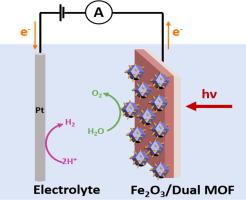Journal of Catalysis ( IF 6.5 ) Pub Date : 2020-09-24 , DOI: 10.1016/j.jcat.2020.09.014 Da Hye Hong , D. Amaranatha Reddy , K. Arun Joshi Reddy , Madhusudana Gopannagari , D. Praveen Kumar , Tae Kyu Kim

|
The performance of oxide photoanodes constructed with hematite (Fe2O3) nanostructures is among the best for low-cost photoelectrochemical water-splitting cells. However, due to limited light absorption capacity, a high photogenerated charge carrier recombination rate, and sluggish surface oxygen evolution reaction (OER) kinetic on the surface, the photocurrent density generated by bare hematite is lower than the theoretical value. To overcome these limitations, we fabricate hematite photoanodes with a dual metal–organic framework (MIL-88B@ZIF-67) coating, which greatly enhances light harvesting efficiency and the intrinsic charge carrier transport rate. Owing to these spectacular advantages, the optimized Fe2O3/MIL-88B@ZIF-67 photoanode affords a stable photocurrent density of 2.52 mA∙cm−2 at 1.23 V vs. a reversible hydrogen electrode (RHE) under one sun irradiation. The photocurrent density is significantly higher than that achieved with a bare Fe2O3 photoanode (0.27 mA∙cm−2). Most importantly, the cathodic shift of the Fe2O3/MIL-88B@ZIF-67 photoanode (119 mV) is larger than that of pristine Fe2O3. The measured incident photon-to-electron conversion efficiency of the Fe2O3/MIL-88B@ZIF-67 photoanode reaches 30.85% at 330 nm. A photocurrent decay of only 5% over 20 h indicates that the photoanode is also extraordinarily stable. We find that it is crucial to precisely control the number of MIL-88B@ZIF-67 coating layers to reduce the charge carrier recombination rate. We expect that our approach will be effective for the design of efficient and stable photoanodes for PEC water splitting.
中文翻译:

金属-有机骨架包覆赤铁矿光阳极对光电化学水分解性能的协同催化行为
由赤铁矿(Fe 2 O 3)纳米结构构成的氧化物光阳极的性能是低成本光电化学水分解电池的最佳性能之一。然而,由于光吸收能力有限,光生载流子复合率高以及表面上缓慢的表面氧生成反应(OER)动力学,赤铁矿产生的光电流密度低于理论值。为了克服这些限制,我们制造了具有双重金属-有机骨架(MIL-88B @ ZIF-67)涂层的赤铁矿光阳极,这大大提高了光收集效率和固有的载流子传输速率。由于具有这些引人注目的优势,因此优化了Fe 2 O 3/ MIL-88B @ ZIF-67光电阳极在一个阳光照射下在1.23 V电压下可逆氢电极(RHE)提供2.52 mA∙cm -2的稳定光电流密度。光电流密度显着高于裸Fe 2 O 3光电阳极(0.27 mA∙cm -2)。最重要的是,Fe 2 O 3 / MIL-88B @ ZIF-67光阳极的阴极位移(119 mV)大于原始Fe 2 O 3的阴极位移。Fe 2 O 3的测得的入射光子-电子转换效率/ MIL-88B @ ZIF-67光电阳极在330 nm处达到30.85%。在20小时内光电流衰减仅为5%,表明该光电阳极也非常稳定。我们发现,至关重要的是精确控制MIL-88B @ ZIF-67涂层的数量以降低电荷载流子复合率。我们希望我们的方法对于设计用于PEC水分解的高效,稳定的光阳极是有效的。











































 京公网安备 11010802027423号
京公网安备 11010802027423号